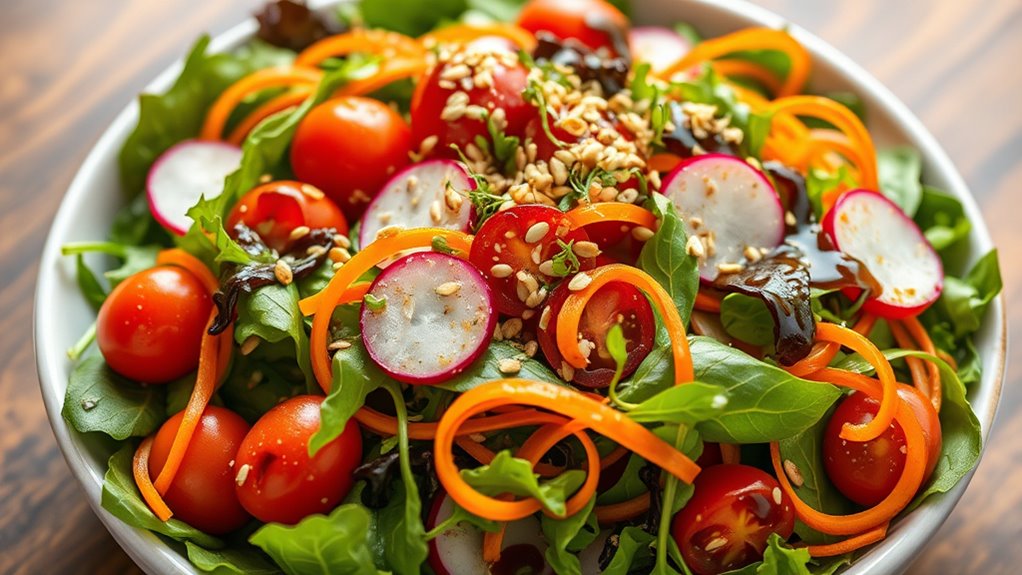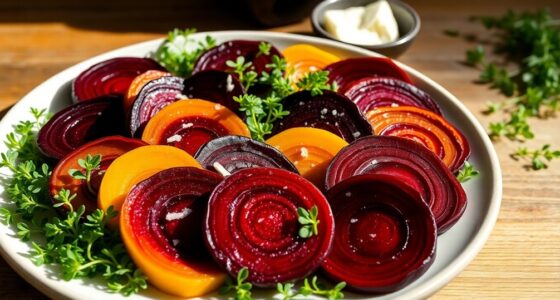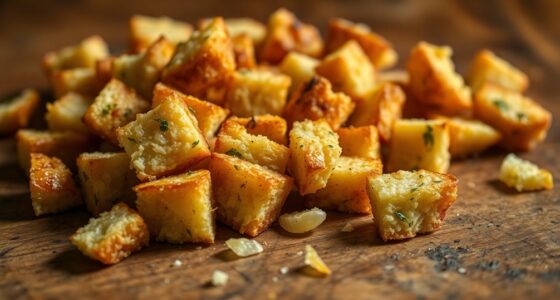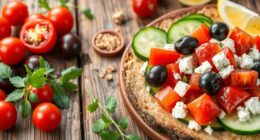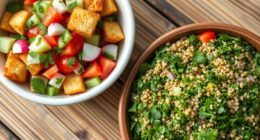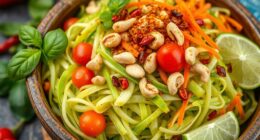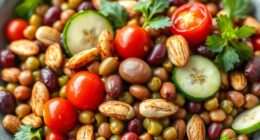Salad trends now feature bold flavors, nutrient-packed superfoods, and creative global influences that turn bowls into exciting, multi-sensory meals. You’ll see colorful ingredients like kale, quinoa, and goji berries, along with international flavors like Middle Eastern herbs or Thai spices. Texture plays a key role, with crunchy nuts or crispy chickpeas adding contrast. If you want to explore how salads have become more personalized and indulgent, stick around for more inspiring ideas.
Key Takeaways
- Creative, globally inspired flavor combinations like Middle Eastern tabbouleh and Thai-inspired bowls are trending.
- Nutrient-dense superfoods such as kale, quinoa, and chia seeds are key ingredients for power salads.
- Texture-rich ingredients like crunchy nuts, crispy chickpeas, and tender greens enhance multi-sensory appeal.
- Customization allows for personalized, balanced meals catering to various dietary preferences and needs.
- Salads now often serve as main courses, blending indulgence, health, and innovative ingredient pairings.
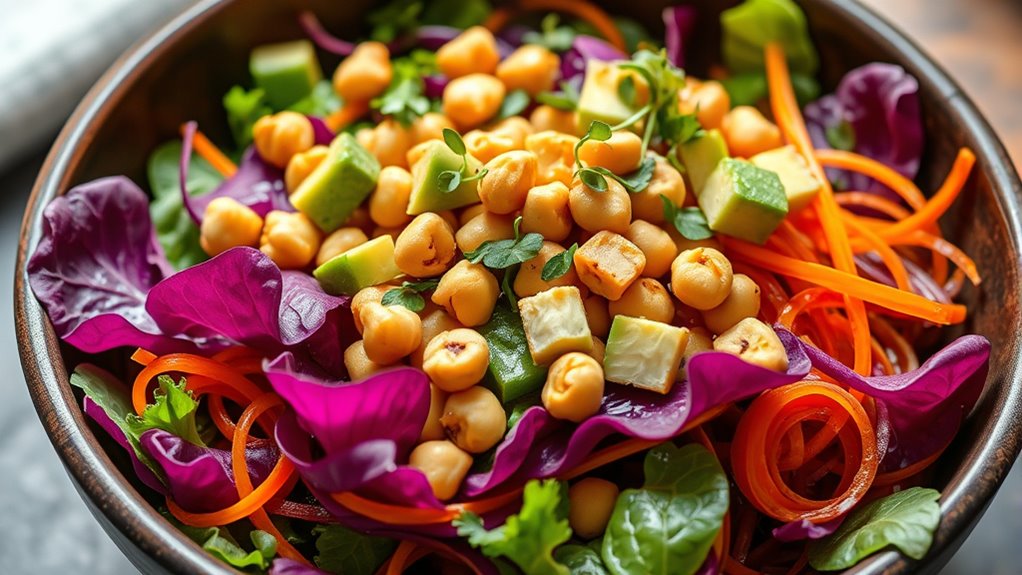
Have salad trends truly evolved in recent years? Absolutely. What once was a simple mix of greens and vegetables has transformed into a creative, health-conscious, and often indulgent culinary experience. Today, salads are no longer just side dishes; they’re becoming the main event, packed with bold flavors, innovative ingredients, and diverse textures. You’re likely noticing more restaurants and home kitchens experimenting with unexpected pairings that push the boundaries of traditional salads. From colorful grain bowls to protein-packed masterpieces, the evolution is evident, and it’s all about personalization and balance.
Salad trends now focus on bold flavors, innovative ingredients, and personalized, balanced meals.
One major shift is the emphasis on superfoods and nutrient-dense ingredients. Kale, spinach, and arugula are still popular, but now they’re often combined with ingredients like quinoa, chia seeds, or goji berries. These additions aren’t just for flavor—they boost your salad’s nutritional profile, making it a true power meal. You might spot salads topped with roasted sweet potatoes, avocado slices, or even seaweed, all of which add not only flavor but also health benefits.
This focus on nutrient density is driven by your desire to feel energized and satisfied after eating, rather than just filling up on empty calories. Incorporating raw food ingredients like crunchy vegetables and healthy fats can further enhance your salad’s nutritional value and texture diversity, supporting your overall health goals.
Another trend you’re seeing is the rise of globally inspired salads. Instead of sticking to familiar ingredients, chefs are blending flavors from around the world. Think Middle Eastern tabbouleh with fresh herbs and bulgur, or Thai-inspired salads with lime, cilantro, and chili. These bold flavor combinations keep salads exciting and encourage you to try new ingredients.
It’s about creating a vibrant, flavorful bowl that satisfies your taste buds while providing a nutritious punch. This trend also reflects your growing interest in diverse cuisines, making salads a versatile canvas for culinary experimentation.
Texture plays an essential role in modern salad trends. Gone are the days of limp lettuce and bland vegetables. Today’s salads are about contrast—crunchy nuts, crispy chickpeas, chewy grains, and tender greens all come together in harmony.
This diversity of textures keeps every bite interesting and satisfying, especially if you’re trying to eat more mindfully. You’re encouraged to think beyond just what ingredients go into the bowl; how those ingredients work together on your palate matters just as much.
This focus on texture elevates salads from a simple dish to a multi-sensory experience. Paying attention to food safety practices when preparing raw ingredients can help prevent foodborne illnesses and ensure your salads remain delicious and safe to enjoy.
Ultimately, salad trends are all about customization and balance. You’re encouraged to mix and match ingredients based on your preferences and dietary needs. Whether you’re seeking plant-based options, high-protein bowls, or low-carb choices, there’s a trend that fits.
The evolving landscape of salads reflects your desire for meals that are fresh, flavorful, and nourishing—showing that salads are no longer just a side but a versatile, exciting part of your culinary repertoire.
Frequently Asked Questions
What Are the Health Benefits of New Salad Ingredients?
You’re curious about the health benefits of new salad ingredients. Incorporating diverse vegetables and superfoods can boost your immune system, improve digestion, and increase your intake of essential nutrients like fiber, vitamins, and antioxidants.
Many trendy ingredients, such as kale, quinoa, or chia seeds, provide sustained energy and may reduce inflammation.
How Can I Make Trendy Salads More Budget-Friendly?
You want to make trendy salads more budget-friendly, so start by using affordable ingredients like seasonal vegetables and canned beans.
Shop at local markets or buy in bulk to save money.
Incorporate grains like rice or quinoa, which are cost-effective and filling.
Avoid pricey toppings and opt for homemade dressings instead of store-bought.
With a little planning, you can enjoy stylish, nutritious salads without breaking the bank.
Are There Any Sustainable Practices in New Salad Trends?
When exploring sustainable practices in new salad trends, you’ll find many focus on eco-friendly ingredients and packaging. You can choose locally sourced, organic produce to reduce your carbon footprint, and opt for reusable containers instead of single-use plastics.
Supporting farms that use sustainable methods also helps. By making these mindful choices, you actively contribute to environmental conservation while enjoying fresh, innovative salads that align with eco-conscious trends.
What Are Popular Dressings for Modern Salads?
Imagine you’re in the Renaissance, and modern dressings like miso, tahini, and avocado vinaigrette are the new court favorites. Today, you’ll find these popular dressings adding bold flavors to your salads, along with classics like balsamic glaze, honey mustard, and Caesar.
They’re versatile, healthy, and elevate your greens with a touch of sophistication. So, experiment with these trendy options to keep your salads exciting and flavorful.
How Do I Incorporate Local Produce Into Trendy Salads?
You can incorporate local produce into trendy salads by visiting farmers’ markets or local farms for fresh, seasonal ingredients.
Choose vibrant vegetables, herbs, and fruits that are in peak season, and add them to your salad for a unique flavor boost.
Experiment with local cheeses, nuts, or proteins to enhance the dish.
This approach not only supports local growers but also guarantees your salad is fresh, flavorful, and aligned with current food trends.
Conclusion
As you embrace these fresh salad trends, you’ll find yourself balancing vibrant, colorful bowls with simple, wholesome ingredients. It’s like pairing a lively, spicy salsa with a calming, creamy avocado—each bite offers contrast and harmony. So, next time you toss a salad, think of it as an artful dance between bold flavors and gentle textures. In this bowl, you’ll discover that the newest trends aren’t just about ingredients—they’re about creating a delicious, balanced experience.
